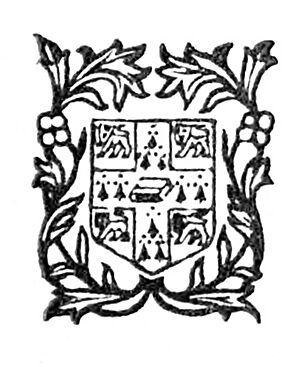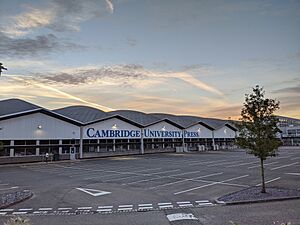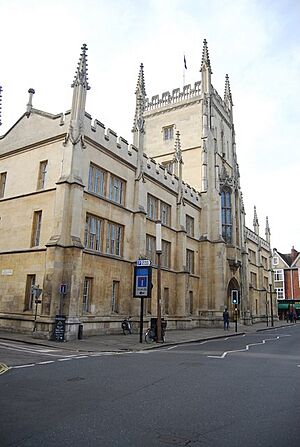Cambridge University Press facts for kids

Logo on the front cover of "The Victorian Age by William Ralph Inge" used by Cambridge University Press
|
|
| Founder | Henry VIII |
|---|---|
| Successor | Cambridge University Press and Assessment |
| Country of origin | Kingdom of England (since 1534) |
| Headquarters location | Cambridge, England |
| Distribution |
|
| Key people |
|
| Nonfiction topics | Humanities; social sciences; science; medicine; engineering and technology; English language teaching and learning; education; Bibles |
| Fiction genres |
|
| Imprints | Cambridge University Press |
Cambridge University Press was a very old publishing company connected to the University of Cambridge. It was given special permission by King Henry VIII in 1534 to print books. This made it the oldest university press in the world! In August 2021, Cambridge University Press joined with Cambridge Assessment to form a new organization called Cambridge University Press and Assessment.
This publisher had offices in over 40 countries around the world. It published more than 50,000 different books and learning materials. These included academic journals, textbooks for schools and universities, and books for learning English. They also printed Bibles and had a bookshop in Cambridge.
Cambridge University Press was a non-profit organization. This means it used its earnings to support its goals, not to make money for owners.
Contents
A Look at History
Cambridge University Press started because King Henry VIII gave the University of Cambridge special permission to print books in 1534. It was one of only two "privileged presses" in England, the other being Oxford University Press. Many famous authors had their works published by Cambridge, including Isaac Newton and Stephen Hawking.
The first University Printer, Thomas Thomas, began printing in 1584. His first book was called Two Treatises of the Lord His Holie Supper. The first Cambridge Bible was printed in 1591. Later, in 1629, a large edition of the King James Bible was printed.
In 1833, a new building for the press, called The Pitt Building, was finished in Cambridge. This building is now a protected historical site.
In the early 1800s, the press helped develop a new printing method called stereotype printing. This allowed many copies to be printed from the same setup. By the 1850s, they were using steam-powered printing machines.
The press started publishing academic journals in 1893 with the Journal of Physiology. By 1910, they were publishing many successful journals, including their first in the humanities, Modern Language Review.
Over the years, the press published works by more than 170 Nobel Prize winners.
In 1949, Cambridge University Press opened its first international office in New York. The press moved to its current main site in Cambridge in 1963.
In 1975, the press started its business of publishing materials for learning English. In 1989, they bought a company called Eyre & Spottiswoode. This gave them the special title of The Queen's Printer, allowing them to print Bibles and prayer books for the Queen.
In 1992, the press opened a bookshop in Cambridge. This spot has been a bookshop since 1581, making it one of the oldest in Britain! In 1999, they launched Cambridge Dictionaries Online.
By 2012, the press stopped doing its own printing. Instead, it started using other companies around the world to print its books.
In 2019, the press introduced "Cambridge Elements." This new idea allowed authors to publish shorter works that were too long for a journal article but too short for a full book.
In 2021, Cambridge University Press officially merged with Cambridge Assessment. The new organization is called Cambridge University Press & Assessment.
People and Printing Styles
Important People in Printing
- John Siberch: He was the very first printer in Cambridge in 1521.
- John Baskerville (1707–1775): He was an official printer. His 1763 Cambridge edition of the King James Bible is considered a masterpiece.
- Stanley Morison (1889–1967): He was a key advisor on typography (the style and appearance of printed matter) for the press.
- David Kindersley (1915–1995): He designed a special typeface called Meliorissimo for the press's buildings and vehicles.
- Gordon Johnson (1943–): He led the group that managed Cambridge University Press from 1981 to 2010.
Key Publications Over Time
- 1584: The first book published by the press was Two Treatises of the Lord His Holie Supper.
- 1591: The first Cambridge Bible was printed.
- 1629: A large Cambridge edition of the King James Bible was printed.
- 1633: The Temple by George Herbert was published. This book included a famous poem called "Easter Wings" where the words are shaped like wings on the page.
- 1713: The second edition of Isaac Newton's famous book Philosophiæ Naturalis Principia Mathematica was published.
- 1763: John Baskerville's beautiful folio Bible was printed, showing off his new ideas for type, paper, and ink.
- 1895: The first book by a Nobel Laureate (someone who won a Nobel Prize) was published. It was J. J. Thomson's Elements of the Mathematical Theory of Electricity and Magnetism.
Current Publications
Open Access Publishing
Cambridge University Press supports "open access" publishing. This means making research and books available for free online to everyone. They offer different ways for authors to publish their work openly. This helps researchers share their findings widely.
They have "Gold Open Access" journals and books, where the content is immediately free. They also support "Green Open Access," which allows authors to put their work in online libraries for free.
In recent years, the press has made agreements with university libraries. These "Read & Publish" agreements allow students and researchers to read all their content and also publish their own work openly.
The press is a member of groups that support open access publishing. In 2023, more than half of the research articles published by Cambridge University Press were available through open access.
Nobel Prize Winners Published
Cambridge University Press has published works by many Nobel Prize winners. Here are some of them:
- J. J. Thomson (Physics – 1906)
- Ernest Rutherford (Chemistry – 1908)
- Niels Bohr (Physics – 1922)
- Werner Heisenberg (Physics – 1932)
- Charles Scott Sherrington (Medicine – 1933)
- Erwin Schrödinger (Physics – 1935)
- James Chadwick (Physics – 1935)
- Patrick Blackett (Physics – 1948)
- John Cockcroft (Physics – 1951)
- Ernest Hemingway (Literature – 1954)
- Alexander R. Todd (Chemistry – 1957)
- Max Perutz (Chemistry – 1962)
- Eugene Wigner (Physics – 1963)
- Max Born (Physics – 1964)
- Nikolay Basov (Physics – 1964)
- Richard Feynman (Physics – 1965)
- Derek Barton (Chemistry – 1969)
- Samuel Beckett (Literature – 1969)
- Simon Kuznets (Economics – 1971)
- Dennis Gabor (Physics – 1971)
- Kenneth Arrow (Economics – 1972)
- Burton Richter (Physics – 1976)
- James Meade (Economics – 1977)
- Nevill Francis Mott (Physics – 1977)
- Herbert A. Simon (Economics – 1978)
- Steven Weinberg (Physics – 1979)
- Abdus Salam (Physics – 1979)
- Subramanyan Chandrasekhar (Physics – 1983)
- Gérard Debreu (Economics – 1983)
- Richard Stone (Economics – 1984)
- Franco Modigliani (Economics – 1985)
- James M. Buchanan (Economics – 1986)
- Wole Soyinka (Literature – 1986)
- Robert Solow (Economics – 1987)
- Pierre-Gilles de Gennes (Physics – 1991)
- Robert Fogel (Economics – 1993)
- Douglass North (Economics – 1993)
- Harry Kroto (Chemistry – 1996)
- William Vickrey (Economics – 1996)
- Claude Cohen-Tannoudji (Physics – 1997)
- William Phillips (Physics – 1997)
- Amartya Sen (Economics – 1998)
- Gerard 't Hooft (Physics – 1999)
- Martinus J. G. Veltman (Physics – 1999)
- James Heckman (Economics – 2000)
- George Akerlof (Economics – 2001)
- Joseph Stiglitz (Economics – 2001)
- Daniel Kahneman (Economics – 2002)
- Vernon L. Smith (Economics – 2002)
- Clive Granger (Economics – 2003)
- Anthony James Leggett (Physics – 2003)
- Edmund Phelps (Economics – 2006)
- Leonid Hurwicz (Economics – 2007)
- Intergovernmental Panel on Climate Change (Peace Prize – 2007)
- Elinor Ostrom (Economics – 2009)
- Thomas A. Steitz (Chemistry – 2009)
- Christopher A. Pissarides (Economics – 2010)
- Peter Diamond (Economics – 2010)
- Christopher A. Sims (Economics – 2011)
- Alvin E. Roth (Economics – 2012)
- Angus Deaton (Economics – 2015)
- Kip Thorne (Physics – 2017)
- Joachim Frank (Chemistry – 2017)
- William Nordhaus (Economics – 2018)
How the Press Works
Connection to the University
Cambridge University Press was a part of the University of Cambridge. It was guided by a group of 18 senior university members called 'Syndics'. These Syndics helped make big decisions for the press.
In 2020, the university decided to combine Cambridge University Press with Cambridge Assessment.
Publishing Areas
Before August 2021, Cambridge University Press had three main publishing groups:
- Academic Publishing: This group published research books and journals in many subjects like science, medicine, and social sciences. They also published Bibles.
- English Language Teaching: This group created courses and materials for people learning English around the world.
- Education: This group made educational products for primary and secondary schools. They also worked with countries to help improve their education systems.
Since August 1, 2021, Cambridge University Press focuses mainly on academic and Bible publishing. The English language and education parts joined with similar departments from Cambridge Assessment.
Working with Others
Cambridge University Press often worked with other organizations:
- In 2011, they partnered with Cambridge Assessment to publish official study materials for English exams.
- In 2015, they worked with Edmodo, a large online learning platform, to bring educational content to schools.
- In 2019, they acquired the Centre for Evaluation and Monitoring, which provides assessments for student progress.
- In 2020, they partnered with an online library called Perlego to offer digital textbooks to students.
- In 2021, Cambridge Assessment and Cambridge University Press officially became one organization: Cambridge University Press & Assessment.
Digital Innovations
In 2016, Cambridge University Press launched Cambridge Core. This is an online platform where you can find all their academic books and journals in one place. It made it much easier for people to find and read their content.
In 2020, they teamed up with Perlego to give students access to digital textbooks. In 2021, they bought a company called CogBooks. This company uses technology that adapts to students, recommending learning materials to help them learn best.
Helping the Community and Environment
Community Support
The press is involved in community activities in Cambridge and other places where its employees live. Each year, they choose a UK charity to support. They have also helped schools in other countries, like Indonesia and Nepal.
They have a program that helps people learn about careers in publishing. By 2022, this program had 200 apprentices in the UK.
Caring for the Environment
Cambridge University Press cares about the environment. They keep track of their energy use, use energy-saving equipment, and try to use less plastic. They also make sure their paper comes from ethical sources.
In 2019, the World Wildlife Fund gave the press its highest score for responsible timber sourcing. The press has won awards for its efforts in sustainability. They are committed to becoming carbon neutral (meaning they don't add to greenhouse gases) by 2048.
The press also supports the Sustainable Development Goals (SDGs). These are goals set by the United Nations to make the world a better place. They publish new open access journals related to these goals, such as Coastal Futures and Global Mental Health.
See also
 In Spanish: Cambridge University Press para niños
In Spanish: Cambridge University Press para niños






